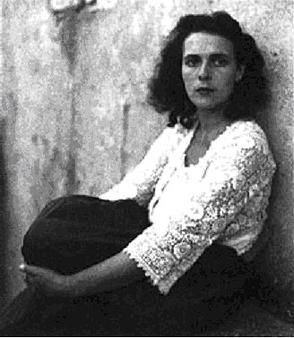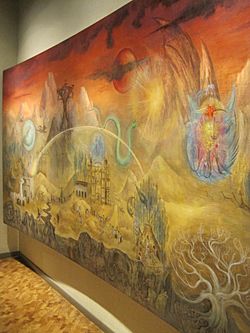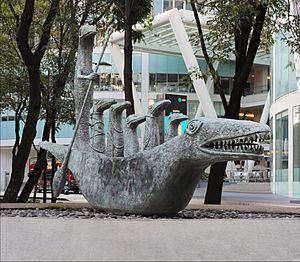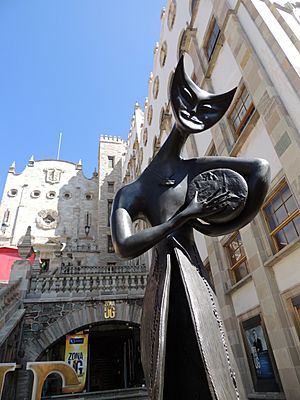Leonora Carrington facts for kids
Quick facts for kids
Leonora Carrington
|
|
|---|---|
 |
|
| Born | 6 April 1917 |
| Died | 25 May 2011 (aged 94) Mexico City, Mexico
|
| Known for | Painting Writing |
| Movement | Surrealism |
| Spouse(s) | Renato Leduc Emerico "Chiki" Weisz |
| Children | Gabriel and Pablo Weisz |
Mary Leonora Carrington OBE (born April 6, 1917 – died May 25, 2011) was a famous British painter and writer. She was known for her unique surrealist art. Leonora spent most of her adult life in Mexico City. She was one of the last artists from the original surrealist group of the 1930s. She also helped start the women's liberation movement in Mexico during the 1970s.
Contents
Early Life and Art Journey
Mary Leonora Carrington was born in Clayton Green, England. She grew up in a wealthy family. Her father, Harold Carrington, owned a textile factory. Her mother, Marie, was from Ireland. Leonora had three brothers. From 1920 to 1927, she lived in a big house called Crookhey Hall. This house greatly inspired her imagination.
Leonora was taught by private teachers and nuns. She was even expelled from two schools because she was quite rebellious! Her family then sent her to Florence, Italy, to attend art school. She also briefly went to a convent school in Ascot.
In 1927, when she was ten, Leonora saw her first surrealist painting in Paris. She later met many surrealist artists. Her father did not want her to be an artist, but her mother encouraged her. In 1935, she studied at the Chelsea School of Art in London. Later, she transferred to the Ozenfant Academy of Fine Arts.
Leonora learned about Surrealism from a book her mother gave her. A poet and art supporter named Edward James really liked her work. He bought many of her paintings. He also arranged a show for her art in New York in 1947. Some of her works are still at James's former home, now called West Dean College.
Meeting Max Ernst
In 1936, Leonora Carrington saw the art of German surrealist Max Ernst at an exhibition in London. She was very drawn to his work. In 1937, they met at a party in London. They quickly became close and moved to Paris together. In 1938, they settled in Saint Martin d'Ardèche, France.
They worked together and helped each other grow as artists. They even made sculptures of animals to decorate their home. In 1939, they painted portraits of each other. Ernst's painting, The Triumph of Love, showed both of them. But Leonora's Portrait of Max Ernst focused only on him. It was full of deep symbols.
Before this, Leonora painted her famous Self-Portrait (also called The Inn of the Dawn Horse). This painting is now at the Metropolitan Museum of Art. In it, she wears white pants and has wild hair. She sits on a chair, reaching out to a hyena. Behind her, a rocking horse flies.
When World War II started, Max Ernst was arrested because he was German. He was released but then arrested again by the Gestapo. His art was seen as "degenerate" by the Nazis. He managed to escape to the United States with help from Peggy Guggenheim.
After Ernst's arrest, Leonora was very upset. She went to Spain. She became very anxious and had delusions. She was admitted to a hospital for care. She later escaped while traveling to South Africa. She went to the Mexican Embassy and met Renato Leduc, a Mexican poet and diplomat. They had a "marriage of convenience" so she could be safe as a diplomat's wife. They divorced in 1943. Leonora and Ernst never got back together.
Life in Mexico
After a year in New York, Leonora and Renato moved to Mexico in 1942. Many European artists went there for safety during the war. Leonora loved Mexico and lived there for most of her life.
When she first arrived, surrealist art was already popular in Mexico. This helped her connect with many artists. Her connections opened doors for Mexican artists too. In 1949, Leonora had her first solo art show in Mexico City. The public and critics loved her work.
In the 1960s, Leonora spent some time in New York City. Then she returned to Mexico. In 1963, she was asked to create a mural. She named it El Mundo Magico de los Mayas (The Magical World of the Mayans). It was inspired by local folk stories. This mural is now in the Museo Nacional de Antropología in Mexico City.
In 1973, Leonora designed a poster for the Women's Liberation movement in Mexico. It showed a "new Eve." She often talked about women's "legendary powers." She believed women needed to reclaim their rights. Many surrealist artists saw women as muses, not as artists themselves. But Leonora was seen as a "femme-enfant" (child-woman) by the Surrealists because she rebelled against her wealthy upbringing.
Leonora believed that true freedom for people could only happen when political freedom was also achieved. She thought it was important for women in Mexico and North America to work together. Her dedication to these ideas led her to win the Lifetime Achievement Award in New York in 1986.
I didn't have time to be anyone's muse... I was too busy rebelling against my family and learning to be an artist.
—Leonora Carrington
Family Life
Leonora later married Emerico Weisz, a photographer from Hungary. They had two sons: Gabriel, who became a writer, and Pablo, who became a doctor and surrealist artist. Emerico, also known as "Chiki," passed away in 2007 at the age of 97.
Later Life and Death
Leonora Carrington died on May 25, 2011, in a hospital in Mexico City. She was 94 years old. She passed away due to problems from pneumonia. She was buried in the English Cemetery in Mexico City.
Artistic Themes and Major Works

Leonora once said, "I painted for myself...I never believed anyone would exhibit or buy my work." Unlike some other Surrealists, she was not interested in the ideas of Sigmund Freud. Instead, she focused on magical realism and alchemy. She used details from her own life and symbols in her paintings. Her work from the 1940s often explored the role of women in creating art.
Leonora's art is closely linked to the surrealist movement. This movement often explored the female body and mysterious forces of nature. When she painted, she used small, careful brushstrokes. She built up layers to create rich and detailed images.
In her Self-Portrait (1938), Leonora explored the idea of being a woman. She used a mirror to show how a person can be both themselves and also an observer. The hyena in her Self-Portrait (1937–38) combines male and female qualities. It represents the worlds of night and dreams. The hyena symbol appears in many of her later works, like her short story "La Debutante."
Leonora was very interested in animals, myths, and symbols. This interest grew stronger after she moved to Mexico. She became friends with another artist, Remedios Varo. They studied alchemy, the kabbalah, and ancient Mayan mystical writings.
Her first important art show was in 1947 at the Pierre Matisse Gallery in New York City. She was invited to an international surrealism exhibition. She was the only female English professional painter there. She became famous almost overnight. In Mexico, she also wrote and published several successful books.
In 2010, a big exhibition of her work was held in the UK. It was part of a series called Surreal Friends. This celebrated the role of women in the Surrealist movement. Her art was shown alongside works by her friends, painter Remedios Varo and photographer Kati Horna.
In 2013, a major show about her work, called The Celtic Surrealist, was held in Dublin, Ireland. It looked at her Irish background and how it influenced her art.
Leonora's art often features horses, like in her Self-Portrait (Inn of the Dawn Horse) and The Horses of Lord Candlestick. She loved drawing horses since she was a child. Horses also appear in her stories. In her first published short story, "The House of Fear," a horse guides a young hero. Leonora often used secret codes in her art. "Candlestick" often represented her family, and "lord" meant her father.
Leonora also helped with the Mexican horror film The Mansion of Madness (1973). She oversaw the artistic design for the sets and costumes. Her son, Gabriel Weisz, also helped. The film features a white horse, which was Leonora's alter ego. The elaborate feasts and costumes show her unique vision.
In 2005, one of her paintings, Juggler (El Juglar), sold for a record price of US$713,000. This was the highest price paid at auction for a living surrealist painter at the time. In 2015, Google Doodle honored her 98th birthday. The Doodle was based on her painting, How Doth the Little Crocodile. This painting was inspired by a poem in Lewis Carroll's Alice's Adventures in Wonderland.
Legacy and Impact
Leonora Carrington is known for bringing a woman's perspective to Surrealism. This art movement was mostly led by men. She showed that women should be seen as artists themselves, not just as inspirations for male artists.
The 59th International Art Exhibition will be called The Milk of Dreams. This name comes from a book by Leonora Carrington. In it, she describes a magical world where life is always changing. Everyone can transform and become someone new.
Leonora's life also inspired a children's book called "Out of This World: The Surreal Art of Leonora Carrington." It tells her story and how she followed her creative talents. She broke away from what was expected of upper-class women in the 20th century.
Artworks
- Self-Portrait (Inn of the Dawn Horse), 1936–1937, The Metropolitan Museum of Art, The Pierre and Maria-Gaetana Matisse Collection
- The Horses of Lord Candlestick, 1938 (private collection)
- The Meal of Lord Candlestick, 1938
- Portrait of Max Ernst, c. 1939, Scottish National Gallery of Modern Art
- The Temptation of St. Anthony, 1945 (private collection)
- The Kitchen Garden on the Eyot, 1946, San Francisco Museum of Modern Art
- The Giantess (The Guardian of the Egg), 1947 (private collection)
- The Old Maids, 1947, Sainsbury Centre for Visual Arts University of East Anglia
- The Bird Bath, 1974
- The Memory Tower, 1995, The Viktor Wynd Museum of Curiosities, Fine Art & Natural History, London
- Gatomaquia, 2009, Museo Leonora Carrington, Mexico
See also
 In Spanish: Leonora Carrington para niños
In Spanish: Leonora Carrington para niños
- Women Surrealists



